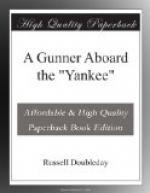After an hour or two, the word was passed to “stow hammocks,” and soon all was shipshape again.
This duty was performed once or twice a week, the frequency depending on weather and circumstances.
Wednesday, July 6th, we passed Sandy Hook and entered New York harbor, just thirty-six days since we left it.
As we made our way up the channel, a pilot boat hailed us and told us of Sampson and Schley’s glorious victory over Cervera.
Though our joy was great and our enthusiasm intense, we were greatly disappointed that we were not in at the death. We felt sure that if we had been there our skipper would have worked the old craft in near enough to have given us a shot.
We steamed on up the bay and through the Narrows, the happiest lot of Jackies afloat. The captain of every vessel we met pulled his whistle cord until the steam gave out, and the passengers cheered and waved their handkerchiefs, or whatever came handy.
The health officer passed us in a jiffy, and before eight bells struck we were safely at anchor off Tompkinsville.
It transpired that we had been sent North on account of a yellow fever scare. The health officer proved that the fear was groundless. Again we set to work cleaning, scrubbing, polishing, and painting, so by the time our friends came crowding aboard, the ship was as neat as a new pin.
The visitors—how glad we were to see them! Only one who has looked danger in the face and realized that there might never be a home-coming in this world, could understand our feelings as our relatives and friends—bless them—came aboard.
Fathers, mothers, brothers, sisters, and other fellows’ sisters crowded up the gangway to greet us.
And all were welcome.
The second day after we anchored, the port watch was given shore leave of twenty-four hours. So we donned our clean blues, and for the first time since May 9th, set foot on solid ground.
As the port watch came over the side the following day, after its liberty ashore, they were met with the order “Shift into working clothes at once and get those shells below.” The red ammunition flag was flying at the foremast head, and all thoughts must be given up of the good times ashore.
The starboard watch then went on liberty ashore and the port watch tackled the ammunition.
From noon till after ten, we were kept busy storing thirteen-inch shells for the biggest guns in the navy. They weigh 1,100 pounds apiece and are dangerous things to handle, not only on account of their weight, but because of the charge of powder each carries. We also loaded eight, six, and five-inch shells into the after hold. We turned in at eleven o’clock, and were roused at 3:30 next morning to begin the same heavy work. When the starboard watch returned the following noon, we were still at it, and they, too, had to pitch in and help as soon as they could get into working clothes.




